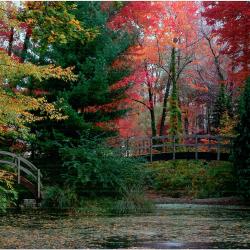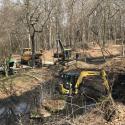Stan Hywet's landscape architect, Warren Manning, envisioned and created a one-acre body of water, from the quarry scarring, at the second highest elevation in the State of Ohio. He was a master at seamlessly integrating his designs into nature. It took six years to demonstrate his vision which was enjoyed by the family all the way up to Mrs. Seiberling’s passing in 1946.
During the late 1970’s grounds keeper William Snyder cleared away the overgrowth and reinterpreted the lagoon area and bridges. It is not yet understood why but through these efforts by 1997 the water level of the lagoon was seven feet below the historic water level with a very poor water quality. Through the restoration of the duck pond, four years later, 100-feet below the lagoon a pump station was created to restore the water level. The historic water level was restored; however, we then discovered the water being pumped 100-feet up hill was leaking out and returning back to the duck pond as fast as it was being pumped. Pumps designed to restore the water lost through evaporation now had to operate continuously to maintain the water level.
In 2008 with the assistance of research studies conducted by the Summit Soil and Water Conservation District, Stan Hywet Hall & Gardens determined that the lagoon requires a comprehensive restoration to return the area to its original design and functionality.
The conceptual plan developed is comprised of the following components:
(1) Drain each pond of the lagoon;
(2) Excavate 30 + inches of sediment and debris;
(3) Repair any breaches in the core wall that retains the water in the west Lagoon;
(4) Line the pond basins with Bentonite clay mats;
(5) Reopen vistas overlooking the National Park. Restore plant material and landscape features to the lagoon; and rediscover and restore the pathway system and bridges around the lagoon;
These project components, as a whole, will complete Manning’s and the Seiberling’s vision for the north end of the estate.
Work on the lagoons began in March 2020.




